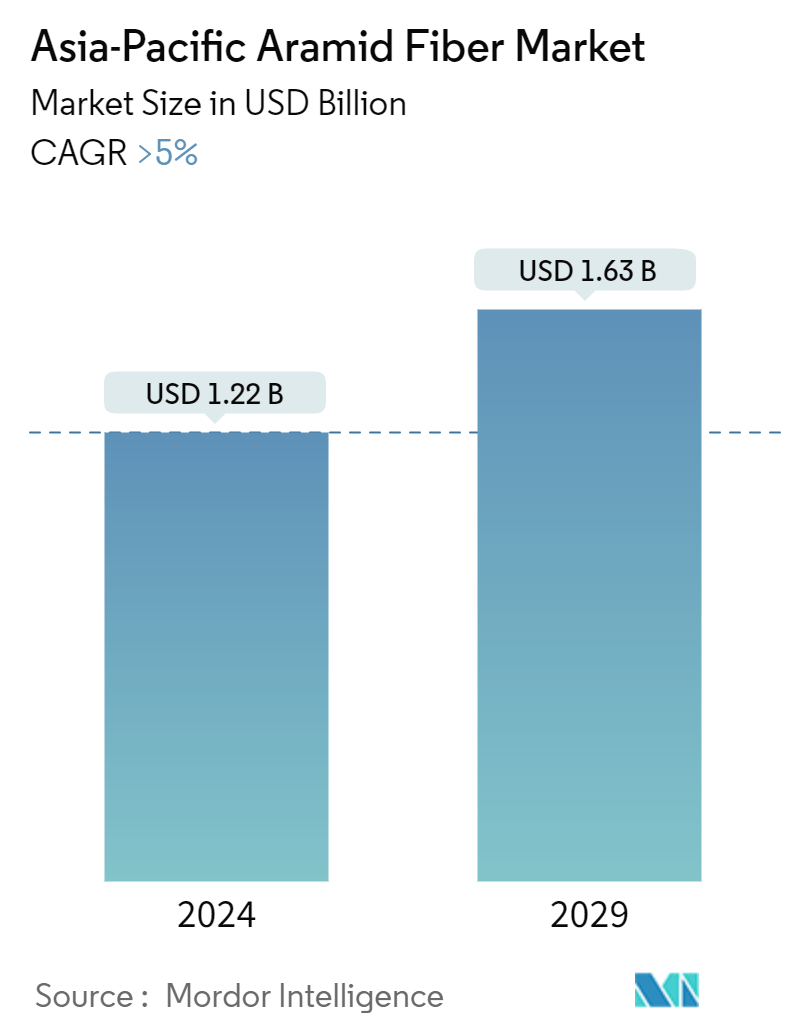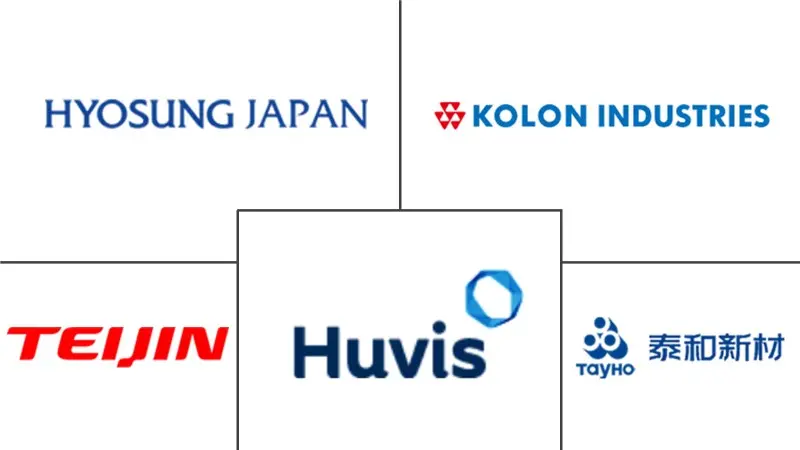Market Size of Asia-Pacific Aramid Fiber Industry

| Study Period | 2019 - 2029 |
| Base Year For Estimation | 2023 |
| Forecast Data Period | 2024 - 2029 |
| Market Size (2024) | USD 1.22 Billion |
| Market Size (2029) | USD 1.63 Billion |
| CAGR (2024 - 2029) | 5.00 % |
| Market Concentration | High |
Major Players
*Disclaimer: Major Players sorted in no particular order |
Asia-Pacific Aramid Fibers Market Analysis
The Asia-Pacific Aramid Fiber Market size is estimated at USD 1.22 billion in 2024, and is expected to reach USD 1.63 billion by 2029, growing at a CAGR of greater than 5% during the forecast period (2024-2029).
In Asia-Pacific, countries like China and India were worst hit by the COVID pandemic, negatively affecting the market. Automotive and electronic manufacturing activities were temporarily halted due to the pandemic, which had decreased the usage of aramid fibers. However, the market recovered well after the restrictions were lifted. The market recovered significantly, owing to the rise in consumption of aramid fibers in the Aerospace and, defense, and automotive industries.
- The increase in demand for lightweight materials in the automotive industry, the rising defense expenditure of India and China, and the increase in the usage of aramid fibers as a potential substitute for steel materials are expected to drive the market.
- The availability of better alternatives for aramid fibers and the non-biodegradable nature of aramid fibers are hindering market growth.
- The growing demand from the aerospace sector and advancements in aramid materials manufacturing technology are expected to create opportunities for the market during the forecast period.
- China is expected to dominate the market due to the rising demand for aramid fibers in the aerospace and defense, automotive end-user industries. It is also expected to register the highest CAGR during the forecast period.
Asia-Pacific Aramid Fibers Industry Segmentation
Aramid fiber is an artificial, high-performance organic fiber that is manufactured from aromatic polyamides. The key characteristics of aramid fiber include high strength, good resistance to heat, abrasion, and organic solvents, non-conductivity, and low flammability. It is mainly used for applications such as composites, ballistics, optical fiber cables, protective clothing against heat and chemicals, and others.
The Asia-Pacific aramid fiber market is segmented by product type, end-user industry, and geography. By product type, the market is segmented into para-aramid and meta-aramid. By end-user industry, the market is segmented into aerospace and defense, automotive, electrical and electronics, sporting goods, and other end-user industries (oil & gas, telecommunications, etc.). The report also covers the market size and forecasts for the Asia-Pacific aramid fiber market for 8 major countries. Each segment's market sizing and forecasts are based on value (USD).
| Product Type | |
| Para-aramid | |
| Meta-aramid |
| End-user Industry | |
| Aerospace and Defense | |
| Automotive | |
| Electrical and Electronics | |
| Sporting Goods | |
| Other End-user Industries (Oil & Gas, Telecommunication, etc.) |
| By Geography | |||||||||||
|
Asia-Pacific Aramid Fiber Market Size Summary
The Asia-Pacific aramid fiber market is poised for significant growth, driven by increasing demand across various industries such as aerospace, defense, and automotive. The market, which experienced a temporary setback due to the COVID-19 pandemic, has shown resilience and is expected to expand steadily over the forecast period. The demand for lightweight materials in the automotive sector and rising defense expenditures in countries like China and India are key factors propelling market growth. Additionally, the use of aramid fibers as a substitute for steel in various applications is anticipated to further boost market dynamics. However, challenges such as the availability of better alternatives and the non-biodegradable nature of aramid fibers may impede growth. Despite these challenges, advancements in manufacturing technology and growing demand from the aerospace sector present promising opportunities for market expansion.
China is expected to dominate the Asia-Pacific aramid fiber market, driven by its robust aerospace and defense industries, as well as its burgeoning automotive sector. The country's significant production of automotive vehicles and the increasing trend towards electric vehicles underscore the growing demand for aramid fibers. In the aerospace sector, China's efforts to reduce reliance on foreign aircraft manufacturers, exemplified by the activities of the Commercial Aviation Corp of China (COMAC), highlight the strategic importance of aramid fibers in domestic aircraft production. Similarly, India's rising defense expenditure and the establishment of new helicopter manufacturing facilities are set to contribute to market growth. The consolidated nature of the market, with key players like Huvis Corp, Kolon Industries Inc., and Teijin Aramid, further underscores the competitive landscape and potential for innovation in the region.
Asia-Pacific Aramid Fiber Market Size - Table of Contents
-
1. MARKET DYNAMICS
-
1.1 Drivers
-
1.1.1 The Increase in Demand for Light Weight Materials in Automotive Industry
-
1.1.2 The Rising Defense Expenditure of India and China
-
1.1.3 The Increase in Usage of Aramid Fibers as a Potential Substitute for Steel Materials
-
-
1.2 Restraints
-
1.2.1 The Availability of Better Alternatives For Aramid Fibers
-
1.2.2 Non-Biodegradable Nature of Aramid Fibers
-
-
1.3 Industry Value-Chain Analysis
-
1.4 Porter's Five Forces Analysis
-
1.4.1 Bargaining Power of Suppliers
-
1.4.2 Bargaining Power of Buyers
-
1.4.3 Threat of New Entrants
-
1.4.4 Threat of Substitute Products and Services
-
1.4.5 Degree of Competition
-
-
-
2. MARKET SEGMENTATION (Market Size in Value)
-
2.1 Product Type
-
2.1.1 Para-aramid
-
2.1.2 Meta-aramid
-
-
2.2 End-user Industry
-
2.2.1 Aerospace and Defense
-
2.2.2 Automotive
-
2.2.3 Electrical and Electronics
-
2.2.4 Sporting Goods
-
2.2.5 Other End-user Industries (Oil & Gas, Telecommunication, etc.)
-
-
2.3 By Geography
-
2.3.1 Asia-Pacific
-
2.3.1.1 China
-
2.3.1.2 India
-
2.3.1.3 Japan
-
2.3.1.4 South Korea
-
2.3.1.5 Malaysia
-
2.3.1.6 Thailand
-
2.3.1.7 Indonesia
-
2.3.1.8 Vietnam
-
2.3.1.9 Rest of Asia-Pacific
-
-
-
Asia-Pacific Aramid Fiber Market Size FAQs
How big is the Asia-Pacific Aramid Fiber Market?
The Asia-Pacific Aramid Fiber Market size is expected to reach USD 1.28 billion in 2025 and grow at a CAGR of greater than 5% to reach USD 1.63 billion by 2030.
What is the current Asia-Pacific Aramid Fiber Market size?
In 2025, the Asia-Pacific Aramid Fiber Market size is expected to reach USD 1.28 billion.

